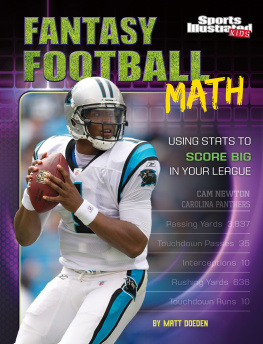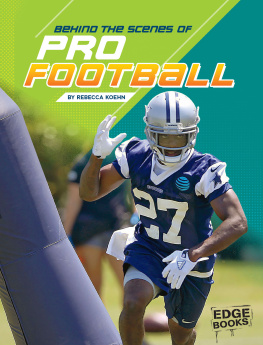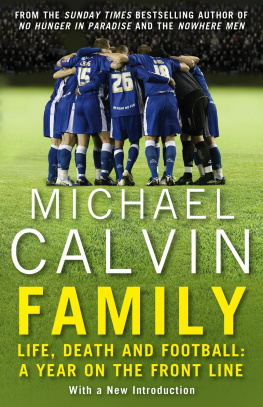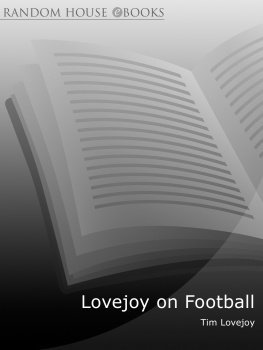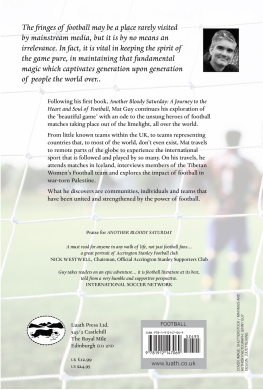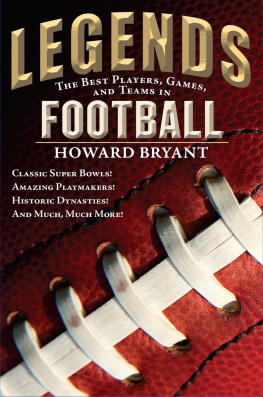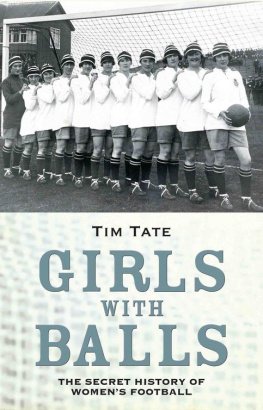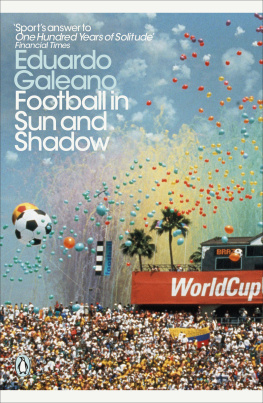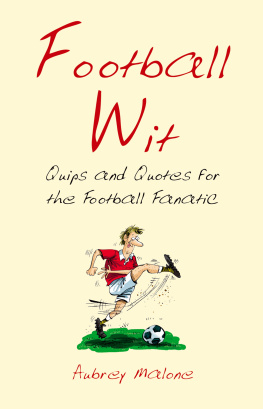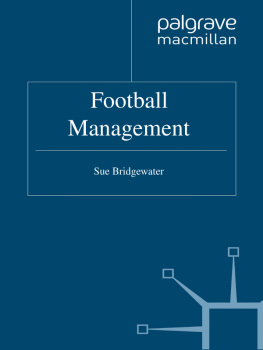First published 2019 by Bloomsbury Academic
Published 2020 by Routledge
2 Park Square, Milton Park, Abingdon, Oxon OX14 4RN
605 Third Avenue, New York, NY 10017
Routledge is an imprint of the Taylor & Francis Group, an informa business
Copyright William Tantam 2019
William Tantam has asserted his right under the Copyright, Designs and Patents Act, 1988, to be identified as Author of this work.
Cover image: Close up of a ball ( Image Source / Getty Images)
All rights reserved. No part of this publication may be reproduced or transmitted in any form or by any means, electronic or mechanical, including photocopying, recording, or any information storage or retrieval system, without prior permission in writing from the publishers.
Notice:
Product or corporate names may be trademarks or registered trademarks, and are used only for identification and explanation without intent to infringe.
A catalogue record for this book is available from the British Library.
A catalog record for this book is available from the Library of Congress.
Typeset by Deanta Global Publishing Services, Chennai, India
ISBN 13: 978-1-350-05654-1 (hbk)
You see in life its about being happy, its not having a lot of money. Ive seen a lot of friends of mine who, in Montego Bay [Jamaicas second largest city], have a lot of money, and a lot of them if theyre not dead, they have to run away. So I realize that money isnt all. Its about being happy. Its about sitting here talking to you about this beautiful game.
Interview with Cavin: 10 November 2012
Each evening in Jamaica, just as the sun begins to set, patches of ground throughout the country that appear derelict and forgotten during the day begin to reverberate with action. Slowly at first, and then more rapidly, people walk onto the open areas. Most are boys and men, but it is increasingly common to see girls and women. They appear from offices, classrooms, homes and street corners, from a spectrum of different economic and social backgrounds. Most are playing neither for money nor for the hope of making it as a professional. Goals appear at either end. These goals might be full sized and set into the ground but are more often scrimmage or pick-up goals which are only thigh high and a metre across. Other pitches make do with piles of rocks, bags or clothing. Some wear football shirts and some have saved up for the newest pairs of boots, while others play barefoot and shirtless. Often there will be some of each on the field. A ball of some description appears, teams are hastily picked and the game begins.
In November 2011, I travelled to Black River, a small coastal town in Jamaica, to research sports-as-development initiatives and to focus on how football was being used within development strategies. However, after two months of fieldwork my focus turned to an amateur football match that was regularly played on a farmers field a little outside the town. Focusing on a single pitch enabled me to concentrate on how football worked within one particular group of men. From the perspective of my initial topic of development, it seemed necessary to question how the sport affected people in a specific context in order to understand how the introduction of football might have an impact on future recipients of sports-as-development. While I attend to the particularities of the field in Black River, I have come to understand since that this field was comparable to others throughout the world where people (certainly not just men) participate in and enjoy sport. My work situates football within a particular historical, social and economic context and examines its impact on those who regularly engage in the game. Through focusing on one football field, this book explains and analyses the role of the sport in producing and negotiating differences of class, age and wealth in a Jamaican community.
I had never been passionate about football even though I had chosen it as a topic of study. I played almost every break time at school from my earliest memories until the age of sixteen, but I never played for any of the top school teams or had any inclination to do so. In one comic moment when I was late to a lesson and as punishment was forced to play with the under-eighteen First-XI at college, the first pass that came my way went straight through my legs. I spent the rest of the match being continually aware of my swiftly dwindling social status as I bungled around the field, unsure of where to stand or run and in perpetual anxiety that the ball might come my way. While I supported Arsenal Football Club, I had only ever seen one live match and rarely watched matches on television. I followed England in World Cups and the European Championships (Euros) and remember my brother and I having tears in our eyes when they were knocked out of Euros 1996 by penalties, but I recognized that others of my friends had a far deeper attachment to their teams. I took for granted that I had been surrounded by football throughout my life in conversations among my peer group, wider social contexts and in the media. It was perhaps due to my lackadaisical relationship with football that I was surprised by the surge of popularity that it received within development agencies. For example, given that the sport was commonly associated with hooliganism (Armstrong 1998), why should football help to rehabilitate former child soldiers in UNICEF training centres, for example (www.unicef.org)? I went to Jamaica with these questions in mind and hoped to find sports-as-social development initiatives in the Black River area and to see how sports were used to further development aims. What I ended up researching appeared, at first, to be very different.
I had visited Black River twice before. My first visit had been in 2006 to help set up a computer lab in what the Jamaican government termed a failing primary school in a nearby community. I returned again in 2008 to conduct a six-week funded research programme for an independent study project as part of my anthropology degree on the subject of sports and Jamaican masculinities. Black River particularly interested me as it was a rural community with a long colonial history that had since suffered significant economic decline. For reasons that I develop below, I decided to change the focus of my research from development initiatives to pick up ball and the role played by football in Jamaican society. After ten days in the field, I began playing three to five matches every week, and this continued for the duration of fieldwork (fourteen months). The other players varied in age from their mid-twenties to their early forties, and while the numbers fluctuated from six to over twenty there was a core set of eight who played nearly every evening from Monday to Friday. The mens love for football initially surprised me, but, as I continued playing, I learnt to love the game and have continued to play every week since my return from the field.
I initially joined the amateur matches in order to get some exercise to meet new people around Black River and to combat boredom. I was also keen to gain a bodily understanding of the sport to complement my work with development agencies. Alongside the writings of C. L. R. James, I consistently referred back to Loc Wacquants research on boxing and boxers in a Chicago ghetto (Wacquant 1995, 2009, 2014). In particular, I returned to his ideas around the social and sensual logic (2004a: 7) of boxing, which showed how adopting the body as both the subject and object of research could be ethnographically productive. I learnt the craft of football through playing it frequently and began to recognize how my body changed over the course of fieldwork. The other players taught me how to cope with nagging injuries and also how to conserve my energy during matches through


